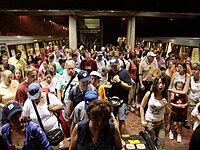Crowd



A crowd is a small and definable group of people, while "the crowd" is referred to as the so-called lower orders of people in general (the mob). A crowd may consist of as many as three to three hundred people. It can also be definable through a common purpose or set of emotions, such as at a political rally, at a sports event, or during looting (this is known as a psychological crowd), or simply be made up of many people going about their business in a busy area (e.g. shopping). Everybody in the context of general public or the common people is normally referred to as the masses.
Terminology
The term crowd is often defined in contrast to other group nouns for collections of humans or animals: aggregation, audience, group, mass, mob, populous, public, rabble and throng. For example in "Public Opinion"[1] Vincent Price compares masses and crowds:
Crowds are defined by their shared emotional experiences, but masses are defined by their interpersonal isolation.
In human sociology, the term "mobbed" simply means "extremely crowded", as in a busy mall or shop. In animal behaviour mobbing is a technique where many individuals of one species "gang up" on a larger individual of another species to drive them away. Mobbing behaviour is often seen in birds.
Social aspects of crowds
Social aspects are concerned with the formation, management and control of crowds, both from the point of view of individuals and groups. Often crowd control is designed to persuade a crowd to align with a particular view (e.g., political rallies), or to contain groups to prevent damage or mob behaviour. Politically organised crowd control is usually conducted by law enforcement but on some occasions military forces are used for particularly large or dangerous crowds.
Psychological aspects of crowds
Psychological aspects are concerned with the psychology of the crowd as a group and the psychology of those who allow their will and emotions to be informed by the crowd (both discussed more comprehensively under crowd psychology), and other individual responses to crowds, such as claustrophobia, agoraphobia and social anxiety. At a general level, crowd psychology is concerned with the behaviour and thought processes of individual crowd members and the crowd as a whole. Given the prevalence of crowd events, and the potential safety issues associated with such large gatherings of people, the topic is receiving increasing attention from agencies responsible for crowd management and also from governments. Many recent studies on crowds have given us new insights on how crowds respond to different situations. One new insight is that it takes approximately 6% of a crowd to change the direction the entire crowd is travelling in. This has also found to be true in non-human crowds, such as flocks of birds and schools of fish.[2]
See also
References
- ^ Public Opinion By Carroll J. Glynn, Susan Herbst, Garrett J. O'Keefe, Robert Y. Shapiro
- ^ Challenger, R., Clegg, C. W., & Robinson, M. A. (2009). Understanding crowd behaviours. Multi-volume report for the UK Government’s Cabinet Office. London: Cabinet Office. http://www.cabinetoffice.gov.uk/resource-library/understanding-crowd-behaviours-documents
